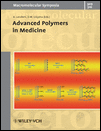In Vivo Application of Poly(1,3-trimethylene carbonate) as a Scleral Buckle in a Rabbit Model
Abstract
Retinal detachments can be repaired with the use of cerclages. Currently non-resorbable silicone scleral buckle implants are used to indent the eye and in that way increase the internal pressure of the eye. The use of resorbable implants has advantages over using non-resorbable materials. High molecular weight poly(1,3-trimethylene carbonate) (PTMC) is a flexible and biodegradable polymer that has great potential in soft tissue engineering and the preparation of resorbable implants like scleral buckles. To be able to use PTMC devices in clinical applications, a full biocompatibility study of the polymer was first evaluated. Then the indentation of the eye over time using a PTMC scleral buckle was assessed in vivo in a rabbit model.




